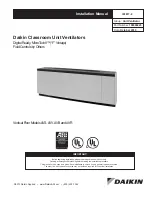
27
INSTALLATION & SERVICE MANUAL FOR PROFESSIONALS
Product description
: Control system strategy
en
Control system strategy
This section describes the control system strategy under different conditions.
If a preheater is installed, the unit can add electrical heating to T1 outdoor air to reduce de-
frosting situations and increase the supply air temperature. However, in situations where the
preheater is not able to keep the heat exchanger frost proof, the unit will start defrosting.
•
Preheating is controlled according to a complex algorithm where, e.g several sensors are
involved. They constantly measure the temperatures, while the system limits the energy
consumption to a minimum.
•
The outdoor air is raised just enough to maintain the air flow and avoid defrosting if
possible.
•
The preheating effect will increase/decrease by 10% every 60 seconds depending on
temperature conditions.
The set points for the temperatures during operation with an active preheating surface are
fixed and cannot be changed.
In cold conditions where T1 outdoor air is below -3 °C, and condensate could build up ice in
the heat exchanger, the unit will start defrosting.
The defrost operating mode is a safety mode, and during defrost the unit cannot switch
to another operating mode until the defrost has ended . When defrosting is active HRC 3
will show “dEF” in the display .
There are two different defrosting strategies:
1. No fireplace in house (default setting)
2. Fireplace in house
You can change the defrosting strategy via PC Tool. However set points for defrosting cannot
be changed.
1 . No fireplace
in house is the default defrosting strategy:
•
The supply air fan speed will slowly decrease until the minimum RPM is reached
•
After 10 seconds, the supply air fan will stop completely while the extract air fan contin-
ues to run continuously to remove any ice.
•
When the defrosting is done, the supply air fan will start at minimum RPM and increase
speed until the originally requested speed is reached.
The defrost operation will lead to a negative pressure inside the house. Depending on the
airtightness of the building envelope it will lead to the following:
1. When the building envelope
is not completely airtight
the “missing” supply air will enter
through small leaks in the building envelope. The defrost operation has the right condi-
tions.
2. When the building envelope
is
completely airtight
and the “missing” supply air cannot
enter through alternative ways, the defrosting will not be as efficient and only work un-
der conditions with low freezing temperatures.
NOTE: Under such conditions we highly recommend a preheater .
Introduction
Preheat
Defrosting mode
!
NOTE
Default defrosting
strategy
!
NOTE
















































